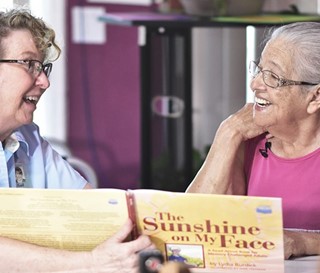Lin Sue Cooney: Soothing the heartbreak of dementia

Dementia care educator Gail Higgenbotham connects with patient Tomasa.
The Arizona Republic
August 26, 2017
For the past year, I've witnessed two dear friends struggle with the same heavy burden.
One spends hours each day coaxing her 91-year-old aunt to wake up and have a bite to eat. Showers have become a battle of wills. My friend smiles, makes cheerful conversation, doles out morsels of chocolate, gets a friendly dog (mine) to visit — anything to bring a little joy into Darlynne's life.
It's exhausting and often futile. The next day, her aunt forgets where she is — and they start all over again.
My other friend watched helplessly as her father slipped further and further away — his memory dissolving in pieces — his mind fabricating an illusion that the people who loved him most were keeping him prisoner.
Jack passed peacefully in his daughter’s loving arms last June, but his long, distressing journey broke her heart over and over again.
This is the cruel reality endured by families caring for a loved one with Alzheimer’s or another type of dementia.
They experience agonizing loss that can stretch over many years and are suddenly plunged into the role of caregiver … a journey so stressful and exhausting they can’t even imagine how to make life more meaningful for their loved ones or themselves.
Chances are, you had no idea that Hospice of the Valley could help.
Our unique Palliative Care for Dementia program is a lifeline for families needing both medical and emotional support.
A dementia educator comes to your home to teach family members what to expect as the disease progresses. How to tell if medications help or harm. How to handle challenging behaviors. How to read non-verbal cues and know when your loved one is hungry, cold or agitated by what’s on TV.
They teach ways to provide comfort, to anticipate and meet needs with a soft, loving approach.
Included in the program are the services of a trained volunteer who provides companionship and gives caregivers a much-needed weekly break to rest or spend time with friends.
Without support, caregivers can easily succumb to depression or illness themselves.
When round-the-clock care is needed, patients can go to Hospice of the Valley’s Gardiner Home — a safe haven nestled in a quiet neighborhood where patients are comforted with compassion, homemade soup and fresh-baked cookies.
One of the most lovely aspects of Hospice of the Valley’s dementia program is something called Quiet Moments.
Dementia Activities Coordinator Gail Higginbotham visits private homes and assisted living communities, much like an explorer on a mission. Her passion is discovering what makes each patient unique. “Turn the right key to unlock what’s inside … and out comes the smiles, if not any words.”
I spent two hours watching her engage 86-year-old Tomasa, who had retreated into quiet solitude over the past few years. But she perked right up when Gail brought out books and puzzles, and soon was turning pages and fitting pieces of colored cardboard together.
Gail presented a vase and flowers, and immediately Tomasa was absorbed in creating a beautiful arrangement.
Gail chatted about Tomasa’s nine children as she handed her a lifelike baby doll. Tomasa cradled and cooed.
But the real transformation happened when Gail played Spanish folk music on her iPad.
“I knew by the way she was sitting in that chair, that she wanted to get up and dance,” said Gail with twinkling eyes. “So we did. And she was leading me!”
As they swayed around the room, I glanced at Tomasa’s grown daughter watching from the doorway— blinking back grateful tears. In that moment, her mom was back. And using what she learned from Gail, she could make that happen tomorrow and the next day. Music and dancing was now their magical way to connect.
What these families discover is how important “moments” are.
Someone with dementia may not remember what happened yesterday, but they can experience joy and peace and security in the present moment.
The journey becomes much like the hospice journey — making the most of the time you have left.
Watch Gail work her magic with Tomasa in our Quiet Moments program here (www.hov.org/our-care/dementia-care/) and for more on the Palliative Care for Dementia program, call 602-636-6363.
Hospice of the Valley’s commitment to dementia care extends to medical students and residents from local hospitals, who get valuable hands-on experience at Gardiner Home. This fall, we’ll teach a course at ASU that pairs students with families caring for a loved one with dementia.
And we are currently accepting applications for 12 Dementia Fellowships, challenging people in medicine, academia, business and art to create better models of care for the future, as the number of people with this disease sharply rises.
Lin Sue Cooney is director of community engagement for Hospice of the Valley. She was a newscaster at 12 News for 31 years.
